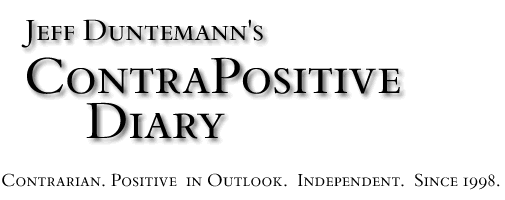|
|
|

|
 March
31, 2008: Tabletop Fluoroscopy for Boys, Circa 1913 March
31, 2008: Tabletop Fluoroscopy for Boys, Circa 1913
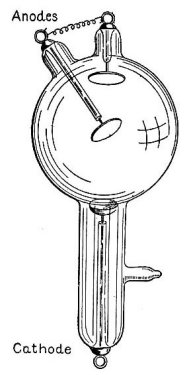 It
took a few minutes of flipping through some books in my workshop,
but I eventually found what I remembered: That one of my "boys"
books contained a description of a tabletop X-ray setup. The book
in question is The Boy Electrician, the first volume of many
from Alfred Morgan, who later wrote The Boys' First Book of Radio
and Electronics and its three sequels, all of which loomed large
in my tinkersome youth. The Boy Electrician was originally
published in 1913 and is now in the public domain. The 1913 edition
has been reprinted by Lindsay Books and I consider it worth having.
There was a significant revision in 1943 that added chapters on
radio and a few other things, and as best I can tell, the copyright
on that edition was not renewed and it too is now in the public
domain. A 40 MB PDF of the 1943 edition is here. It
took a few minutes of flipping through some books in my workshop,
but I eventually found what I remembered: That one of my "boys"
books contained a description of a tabletop X-ray setup. The book
in question is The Boy Electrician, the first volume of many
from Alfred Morgan, who later wrote The Boys' First Book of Radio
and Electronics and its three sequels, all of which loomed large
in my tinkersome youth. The Boy Electrician was originally
published in 1913 and is now in the public domain. The 1913 edition
has been reprinted by Lindsay Books and I consider it worth having.
There was a significant revision in 1943 that added chapters on
radio and a few other things, and as best I can tell, the copyright
on that edition was not renewed and it too is now in the public
domain. A 40 MB PDF of the 1943 edition is here.
The Boy Electrician explains that "it is possible to
obtain small X-ray tubes that will operate satisfactorily on an
inch and one half spark coil." This does not refer to the coil's
dimensions; it means a coil capable of generating a spark an inch
and a half long. He goes on to say that X-ray tubes cost about four
and a half dollars each (albeit 1913 dollars) and may be obtained
from laboratory supply houses. Hookup is fairly simple, with the
spark coil driven by four of those wonderfully gutsy #6 dry cells
with the huge carbon rod running down the middle. The drawing of
the setup is shown below:
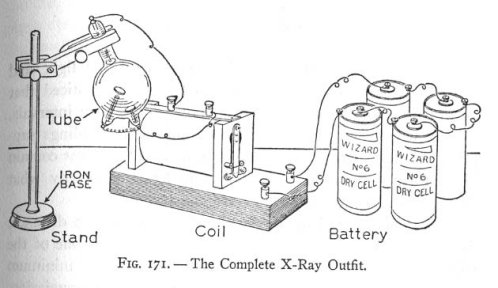 Morgan
explains that you can either view images directly with a fluoroscope
or expose ordinary photographic plates by placing an object to be
X-rayed between the tube and the plate and leaving it there for
fifteen minutes. This includes things like purses, mice, or...your
hand. If you have the money, he also explains that a hand-held fluoroscope
may be constructed by simply coating a sheet of white paper with
crystals of platinum barium cyanide. It looks like the fluoroscope
screen is used by basically staring at the X-ray tube with the object
to be X-rayed between the tube and the paper screen. Morgan
explains that you can either view images directly with a fluoroscope
or expose ordinary photographic plates by placing an object to be
X-rayed between the tube and the plate and leaving it there for
fifteen minutes. This includes things like purses, mice, or...your
hand. If you have the money, he also explains that a hand-held fluoroscope
may be constructed by simply coating a sheet of white paper with
crystals of platinum barium cyanide. It looks like the fluoroscope
screen is used by basically staring at the X-ray tube with the object
to be X-rayed between the tube and the paper screen.
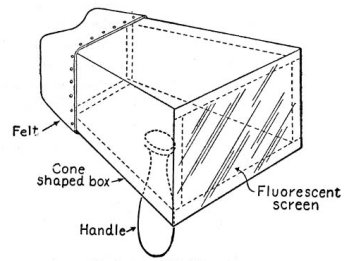 It
would be interesting to know just how many boys bought the tube
and tried to make it work; though given that $4.50 in 1913 would
be about $100 today, I doubt it was many. Nor do I know how toxic
platinum barium cyanide is, but I'm guessing a little more than
iron filings. (On the other hand, my 1962 chemistry set contained
a little bottle of sodium ferrocyanide, which sounds much worse
than it actually is.) It
would be interesting to know just how many boys bought the tube
and tried to make it work; though given that $4.50 in 1913 would
be about $100 today, I doubt it was many. Nor do I know how toxic
platinum barium cyanide is, but I'm guessing a little more than
iron filings. (On the other hand, my 1962 chemistry set contained
a little bottle of sodium ferrocyanide, which sounds much worse
than it actually is.)
I remember taking The Boy Electrician out of the Chicago
Public Library when I was 12 or so and pondering the X-ray project.
What stopped me wasn't any fear of X-rays themselves, but concern
that the whomping big spark coil would wipe out TV reception for
a quarter mile in every direction and get me in trouble with the
FCC. My friend Art had an old Model T ignition coil, and we could
hear it sizzling on Art's transistor radio for half a block. The
project had to be safe; I mean, the book was in the juvenile
section of the library...
We knew less about a lot of things in 1913; X-rays were in some
respects the least of it. But the hazard is significant, if
not as bloodcurdling as luddites specializing in radiation insist.
People used to self-treat insomnia by inhaling chloroform; well-known
British scientist Edmund Gurney died by falling asleep with a chloroform-soaked
cloth next to his nose. We know more now, and understand the precautions
a great deal better, which has led to an escalation of conern that
(untempered by any grasp of statistics or risk evaluation) quickly
descends to rank superstition. One has to wonder how much knowledge
isn't obtained these days simply because people are afraid
of small but nonzero hazards. Panic over traces of phthalates—then
heedlessly drive fifty miles to a football game with a car full
of kids. It's the modern way of life.

|
 March
30, 2008: Shoe-Fitting Fluoroscopes March
30, 2008: Shoe-Fitting Fluoroscopes
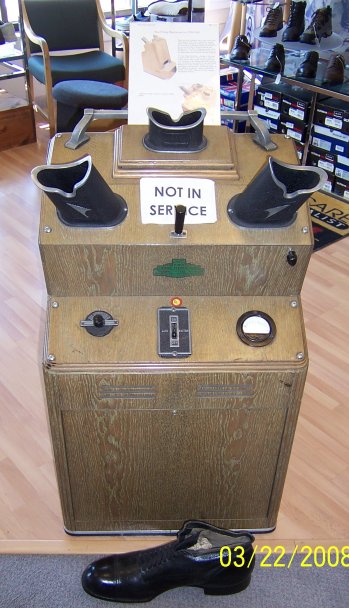 Just
got back from Chicago and there's way too much to do (and I have
a six-hour dental appointment scheduled for Thursday!) but
I did want to report on something I saw on our trip that I haven't
seen for a very long time: A shoe-fitter X-ray machine. People my
age or older may remember going to a shoe store in the 1950s or
earlier, and having your parents and the shoe store man look at
your feet inside a new pair of shoes to make sure they fit correctly.
I know I did this, and I vaguely remember the humming machine, but
I suspect I was just too short to get to look into the machine myself.
(I doubt I would forget a real-time X-ray image of my own bones.
Urrrrp...) Just
got back from Chicago and there's way too much to do (and I have
a six-hour dental appointment scheduled for Thursday!) but
I did want to report on something I saw on our trip that I haven't
seen for a very long time: A shoe-fitter X-ray machine. People my
age or older may remember going to a shoe store in the 1950s or
earlier, and having your parents and the shoe store man look at
your feet inside a new pair of shoes to make sure they fit correctly.
I know I did this, and I vaguely remember the humming machine, but
I suspect I was just too short to get to look into the machine myself.
(I doubt I would forget a real-time X-ray image of my own bones.
Urrrrp...)
Carol and I stopped at Square Deal Shoes in downtown Des Plaines
last Saturday. We both bought shoes to leave at our condo so we
don't have to pack them on future trips. While browsing the stock
I also looked at their Simplex X-Ray Shoe Fitter. The machine was
disabled (they've been illegal since 1970) but it was otherwise
in very good shape, housed in a marvelous Raymond Loewy-ish Art
Deco wood cabinet.
An excellent short history of this peculiar phenomenon is here.
The machine shown in the article is, I believe, a more deluxe version
of the one I saw at Square Deal Shoes; both were made by X-Ray Shoe
Fitter, Inc., of Milwaukee. The name 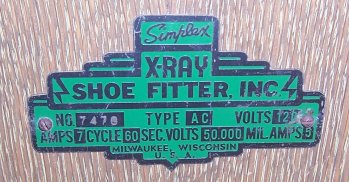 plate
(below) indicates that the power supply drew 7 amps and put out
50,000 volts at 5 milliamps. That kind of power will generate considerable
radiation out of an X-ray tube, and the associated hazards eventually
put an end to continuous-beam fluoroscopy by untrained operators,
in shoe stores and elsewhere. The hazards appeared not so much to
the occasional shoe store customer as to the sales reps who ran
the machines and sometimes to professional shoe models who tested
shoes for manufacturers using machines like this; one woman's foot
was damaged so badly in testing shoes that it had to be amputated. plate
(below) indicates that the power supply drew 7 amps and put out
50,000 volts at 5 milliamps. That kind of power will generate considerable
radiation out of an X-ray tube, and the associated hazards eventually
put an end to continuous-beam fluoroscopy by untrained operators,
in shoe stores and elsewhere. The hazards appeared not so much to
the occasional shoe store customer as to the sales reps who ran
the machines and sometimes to professional shoe models who tested
shoes for manufacturers using machines like this; one woman's foot
was damaged so badly in testing shoes that it had to be amputated.
Square Deal Shoes has been in business since the 1920s, and in
earlier times they also made custom shoes. One the current owner
showed me was the shoe of Robert
Wadlow, who at 8 feet 11 inches was the world's tallest man
in the 1930s, and possibly the tallest man in recorded history.
The shoe was technically size 37, and although I placed the shoe
in front of the X-Ray machine in the photo above, it just makes
the machine look small; the damned thing was in fact as long as
my forearm.
As I mentioned in my entry for March 25,
2008, the world is full of odd things like this. Get out, look
around, pay attention, and you'll see them.

|
 March
25, 2008: Rail Trails and the Narrowest Storefront March
25, 2008: Rail Trails and the Narrowest Storefront

The weather today in Chicago promised to be as good
as it gets this trip, so I decided to do a little exploring. I wanted
to get some exercise and a little sun on my face, and run down to
a neighborhood I hadn't set foot in for almost thirty years: Sauganash,
an upscale part of the Northwest Side where my father's parents
lived in the 1950s and 1960s. I went past the old house (at the
corner of Kedvale and Glenlake), which had not changed at all, though
the tree that my grandfather had planted in 1955 was now huge and
breaking up the sidewalk. I had lunch at a hot dog place at Devon
and Pulaski and parked the car on Pulaski near St. Odisho's Assyrian
Catholic Church. I then did something interesting: I walked the
old rail line that intersects Pulaski near Granville, southward
as far as the Chicago River, roughly at Balmoral. The rails are
still there, but by the depth of their rust I'd guess they hadn't
seen wheels for a number of years. It was a little weird walking
over Peterson on the rail bridge, but I wanted to see if there was
any evidence of there having been a commuter rail platform at Peterson.
I'm not sure why, but I always thought my grandfather boarded a
train for downtown (he worked at First National Bank) on Peterson
somewhere. This was clearly not the place. (Gretchen says he boarded
at Edgebrook, and she's probably right.) Whatever that line was,
it had clearly been freight-only.
Since I was on the right of way, I just kept going. The tracks
continued, rusty and weed-choked, as far as I went. Just a block
south of Bryn Mawr, a second line merged with it, and I found that
the city was in the process of making a walking trail out of the
old bed. So I cut north again on the walking trail, passing people
and their dogs and a father flying a kite with his preschool son
in a schoolyard. The trail is quite new, and in fact the walking
bridge over Peterson was not complete yet and was fenced off. (The
trail goes north as far as Devon.) So I skidded down the embankment
and walked east back to Pulaski along Peterson to my car. It was
a nice two-and-a-half mile stride, and when the sun was out it was
quite warm.
That accomplished, I drove back west toward Des Plaines, and stopped
in Park Ridge to do a little more walking. I wanted to visit Hill's
Hobby Shop, and walked there only to find that they have moved to
Buffalo Grove. I did, however, snap a shot or two of what is certainly
the narrowest storefront in Park Ridge (and perhaps the whole Chicago
metro area) at 147 1/2 Vine Avenue (60068) directly across the street
from Park Ridge City Hall. I didn't have a tape measure in my pocket,
but I'm guessing the whole thing was between four and five feet
wide.

I'd seen it before, and remembered that it had been a knicknack
shop a few years ago. Sure enough, googling the address showed it
to have been (aptly) The Miniature Gallery, and there was a 2007
business registration sticker on the window. However, the counter
and window displays had been ripped out, and it looks like it's
being converted to something else, probably a hall to the rear.
The art gallery in the rest of the building was also vacant, and
the building as a whole was not in terrific shape.
No serious point to be made here, other than you miss some odd
and occasionally wonderful things by driving everywhere. Spring's
coming—so get out on shank's mare and see some of the weird
stuff in your own neighborhood!

|
 March
24, 2008: Odd Lots March
24, 2008: Odd Lots
- I've had a difficult week here; new dental problems have arisen,
culminating in an unplanned root canal this past Thursday, followed
almost immediately by a much-delayed flight from Denver to Chicago
for an Easter visit, where they happened to be having a blizzard.
(The earliest Easter since 1913 corresponded with a lingering
winter across the Midwest.) Tooth troubles continue, so if my
posts have been (and continue to be) a little sparse, that's most
of the reason.
- Our early Easter this year caused some people to ask how the
date of Easter is calculated. Well, it's
not pretty. At least next year it happens in April, whew.
- Here's a
nice article describing a problem that is by no means recent:
The split between people in the Catholic Church who can worship
with a light heart, and people who invariably equate reverence
with grimness . This has been an issue at least since Pope Pius
IX lost the
Papal States in the mid-1800s, after which the Papacy became
obsessed with its authority and lost any ability to laugh at itself
or anything else. (Pope John XXIII bucked the trend, but we didn't
have him anywhere near long enough to make a permanent difference.)
Roman Catholicism needs a sense of humor far more than it needs
a Pope, but this may be one of those things that won't be solved
within my own lifetime.
- In keeping with its long history of contempt for the consumer
(which, in all fairness, is rife in Japan) Sony attempted to charge
purchasers of its laptops $49 not to install a crippling
load of crapware on the machines. Apparently they've taken so
much flak for it that they
recently dropped the fee. What I find boggling is that they
willingly cripple their own machines by selling huge numbers of
crapware slots, which makes you wonder how much money they
make in the crapware business. We may be heading down the same
path here for laptops that printers have followed, in which the
printer is a thin, shabby thing sold for very little that makes
money for its parent company by consuming artificially expensive
ink/toner cartridges.
- It seems that I've been hearing a great deal within my own circle
of contacts about people who try to help nontechnical folks (often
parents) make Vista work with existing peripherals and software.
The script goes like this: Nontechnical person brings home a new
Vista PC or laptop from Best Buy and tries to install older software
or connect it to various external hardware devices. Install fails;
system aborts in various weird ways; technical person tries to
fix (or simply understand) the failure, to no avail. Moral here:
Do not use Vista. Everything that isn't needless window
dressing is there for Microsoft's or Big Media's benefit, not
yours. (Reread the venerable Vista
Failure Log if you haven't read it for awhile.) You can still
order PCs from vendors like Dell with XP preinstalled. Do it while
you still can. And failing that, start researching Ubuntu/Kubuntu.
- Speaking of failure, WiMax (which we have seemingly been waiting
for since the last ice sheets retreated) may be a failure because
it's lousy technology. The wireless DOCSIS technology mentioned
in the linked article as a solution has been around for some years
and doesn't have a much better reputation. We may in fact be asking
too much of low-power microwave broadband systems—fixed point-to-point
broadband is totally at the mercy of topography and even vegetation—and
I keep coming back to the conviction that some sort of "roof-hopper"
mesh network may be the best path to follow. People
are doing this in some areas; why it isn't seen as a more
general solution puzzles me.

|
 March
19, 2008: The Big Dog Walking Quadriped Robot March
19, 2008: The Big Dog Walking Quadriped Robot
Don't have much time today, but I did want to call your attention
to an item aggregated on Slashdot: The Boston
Dynamics "Big Dog" robot prototype, developed as a
cargo mule for DARPA. Here's a
must-see video of Big Dog in action, climbing up a wooded hillside,
tramping through snow, and walking on ice. At one point a technician
kicks the device hard on one side, and it recovers its balance beautifully
without falling over, all the while carrying a load that weighs
30% more than itself. It uses a gait that looks more like a show
dog's than a draft horse's, and while they do not demonstrate it
in full gallop, they're clearly trying to teach it to run.
Scary item, considering that this would have been impossible just
a few years ago. I flashed on Cordwainer Smith's Manshonyoggers
(from the German Menschenjaeger, man-hunter) which are human-scale
Berserkers that run around a ruined world and kill any human being
they see. Though hardly stealth creatures now, that's mostly engine
noise and is a minor engineering problem. It'll be interesting to
see what we do with them in a few years—or what the Bad Guys
do with them in another fifteen or twenty.

|
 March
18, 2008: The Final Odyssey March
18, 2008: The Final Odyssey
I had breakfast with Isaac Asimov. I shook hands with Robert Heinlein.
Kate Wilhelm did a tarot reading for me. I've workshopped with Gene
Wolfe, George R. R. Martin, and A. J. Budrys. Nancy Kress is still
a close friend. David Gerrold wrote for my magazine for ten years.
I saw Keith Laumer from a distance once, and have had several conversations
with Larry Niven and David Brin. But I have never been anywhere
close to Arthur C. Clarke. Now I won't get the chance; as I learned
on arriving at home this evening, he has died in Sri Lanka at age
90.
Arthur C. Clarke was my favorite SF writer for a long time. Asimov
was a little dull, and Heinlein's stridency bothered me at times,
but Clarke was as close to perfect as SF writers got for me, at
least in high school—and maybe still. His SF was about ideas,
and he let nothing else get in the way of those ideas. I began writing
SF by imitating his short stories. When I later began writing SF
novels I was imitating Keith Laumer, because I knew damned well
that I could never imitate Against the Fall of Night or Childhood's
End.
As I
have reported here more than once, when I was seventeen I gulped
and asked a beautiful girl to go out with me and see 2001: A
Space Odyssey. She said yes. Seven years later, Carol said yes
again, when I asked her to share a different kind of odyssey with
me. Yup, Arthur C. Clarke landed me first a best friend, then a
lover, and finally a spouse. (One doesn't get that kind of service
from Barry Malzberg.)
There's not much more to say. When a man gets to be 90 before he
dies, I don't mourn, I celebrate. We had him a long time, and now
he is free of all the suffering and limitations inherent in flesh.
I happen to think that I may meet him yet...but let that pass. We
have his stories. He worked his magic on me, and I would not be
the writer I am if he were not the writer he is.
Just one more word: Thanks, Sir Arthur. Really. And thanks again.

|
 March
17, 2008: The Secret to Making Good Wine March
17, 2008: The Secret to Making Good Wine
Basically, charge more for it. That's all it takes, and
I roared when I read the
account on the Boston Globe site. Take that, ye wannabe
wine snobs! In summary, when people have not learned the subtleties
of wine flavors, they fall back on the assumption that good wine
is more expensive than so-so wine, so when told how much a bottle
of wine costs without being told what it is, they overwhelmingly
declare that the more expensive wine is the better wine—even
when all the wines in the tasting are exactly the same wine.
Heh.
Perceiving the subtleties of wine is like playing the piano, or
most any other musical instrument: It takes years of practice, and
(though we may mightily deny it) many or even most people have no
talent for the skill and cannot learn it. Add that to the fact that
human taste perception varies wildly from individual to individual
and cannot be quantified, and, well, it cooks down to this: Buy
what you can afford and learn to like it, as the odds are that you
cannot tell the difference between good and ordinary wine anyway.
From the article:
After the researchers
finished their brain imaging, they asked the subjects to taste
the five different wines again, only this time the scientists
didn't provide any price information. Although the subjects had
just listed the $90 wine as the most pleasant, they now completely
reversed their preferences. When the tasting was truly blind,
when the subjects were no longer biased by their expectations,
the cheapest wine got the highest ratings. It wasn't fancy, but
it tasted the best.
The larger issue, that expectations color what we consider "objective"
perception, is worth close study, as it applies to a lot more than
just wine. People say that house brands are inferior to name brand
only when they're told which is which. Our sense of taste is not
as good as we think, nor are our skills of perception. I don't buy
brand name Rice Chex anymore, nor real Diet Mountain Dew. (And we
buy Joe's Os when we're somewhere that they're sold; they beat Cheerios
all hollow.) I save money, and I'm just as happy as I was going
with name brands. Objective quality is perceptible (and thus definable)
for some things, less so for other things, and not at all for a
great many (perhaps most) things. Being able to tell which is which
is an important skill. Don't assume that you know more than you
do, nor that you can discern more than you can.
A recent phone conversation with Michael Abrash triggered some
insights in this area. More on it when I find the time. And thanks
to several people who sent me the Boston Globe link; I believe Rich
Rostrom was the first.

|
 March
15, 2008: How (Not) to Wire Up Hotel Broadband March
15, 2008: How (Not) to Wire Up Hotel Broadband

Was cleaning out my digital camera and came upon a shot I had forgotten.
Some time back we were in a hotel room with $9.95/day wired broadband
(via DSL) and I happened to look under the desk in the room. Boy,
there was a mess down there like I haven't seen in a while. I never
quite figured out what all that wirework was for, precisely, but
it included two hasty splices partially wrapped in plastic electrician's
tape, plus a hotel pen that had fallen off the rear edge of the
desk and become lodged in the wad. (Dead center.) Wires had been
pulled out from behind the telephone jack plate and spliced into
a 4-pin phone jack that was literally dangling over a hanked-up
data cable. Remarkably, broadband worked just fine—and that's
the reason I didn't try to rescue the pen.

|
 March
14, 2008: Odd Lots March
14, 2008: Odd Lots
- While chasing an interesting "out of the blue" idea
that came to me while exercising the other day, I happened upon
an
RV surplus shop. Not surprisingly, it's in Elkhart, Indiana
(Ground Zero for the American RV industry) and it sells leftovers
and overstocks of RV parts and interior furniture. If I were to
want to built a custom RV dinette table with a built-in keyboard,
well, this might be the place to start.
- Good grief: Has Big Media run out of Republicans to torment?
ABC News posted this
story about the pastor of Obama's Chicago church, who repeatedly
condemns the US in his sermons and tells his people that they
should be singing "God Damn America" instead of "God
Bless America." Expect those sermons (which are offered for
sale by the church) to become very popular in coming months.
- Illinois is famous for a lot of things, but being the historical
capital of manufacturing of fraternal organization initiation
and hazing equipment is not one of them. However, the
De Moulin Company of Greenville, Illinois, now known for making
band uniforms, used to do a big and almost unimaginably bizarre
business manufacturing expensive
gag items used to make new Masons and Elks feel like one of the
gang. The precise psychology here is obscure to me (the last
remotely fraternal organization I joined was the Boy Scouts) but
the
devices are just insane. Browse and boggle.
- Here's another source
for home-made telescope optics and truss
telescope kits up to 32" in clear aperature. Even though
I'm not a big Dobsonian fan, the scopes look good, and if you
want light-gathering power above all else something like this
is as good as you're going to do short of a full-concrete observatory.
The optics are not cheap, but
they're good. (Thanks to Pete Albrecht for the link.)
- Also from Pete comes a link to a site selling Swiss
Army Ohmmeters. Should the Swiss Army encounter resistance,
well, they'll be ready.
- Mike Burton (who worked in the industry for some time) wrote
to say that "double shot" keyboards are no longer produced
due to their expense. A double-shot keyboard is one in which the
keycaps are molded in two steps: One step to mold the body of
the cap, with a void in the shape of the letter, and a second
to fill the void with black plastic. Such keycaps never lose their
legends, like my decal-equipped Avant Stellar is now doing at
great speed. I guess I had better stock up on period Northgates.
- We have evidently found
the gene that triggers the onset of puberty. One wonders what
suppressing this gene would do long-term. What would be the psychology
of a 75-year-old boy who had never gone through puberty? Larry
Niven toyed with the idea in World Out of Time, speculating
that stopping puberty would stop aging, but I intuit that much
more could be done with it. Would I give up sex for a shot at
becoming immortal? (Answer from this side of the fence: No. Ask
me in 1962 and you might have gotten a different answer.) Much
depends on whether emotional maturity is a process inherent in
or only affected by puberty. Sooner or later some renegade will
try this, and we'll know.

|
 March
13, 2008: Borders Focuses on Impulse March
13, 2008: Borders Focuses on Impulse
An
article from yesterday's Wall Street Journal basically
confirms Borders' ceding some territory in their war with online
booksellers both used and new. (And "gently used," i.e.,
read once and resold online.) Borders has begun a new shelving strategy
in which a great many more books are shelved face-out rather than
spine-out. To make room for all those additional face-outs, the
chain will be reducing the numbers of titles carried per store by
5%-10%. For the larger stores, that will mean 4,000-9,000 fewer
titles carried.
The doofy marketing consultant quoted in the article tells us that
"People don't want choice, they want what they want."
I hope Borders didn't pay him too much, because that's an abysmally
stupid statement. People who want what they want order online at
a steep discount. People who shop at Borders (and other large bookstores)
often don't know what they want—which is precisely why
Borders is changing to face-outs on their shelves. When I know precisely
what book I want, I order online, in part because I'm contrarian
in my book tastes, and in part because I don't like to drive when
I don't need to. I go to bookstores these days mostly when I have
to hit the mall for something else. (My own experience shows that
buying shoes online is an exercise in futility.) On those occasions
I budget some time for Borders or B&N, specifically to buy a
few titles on impulse. Impulse will be easier now. Serendipity
has value, and prowling bookstore aisles can broaden one's tastes.
(Ordering only what one wants tends to narrow one's tastes, just
like hanging out only with people like oneself tends to create a
social circle of people a great deal like oneself.)
For impulse buying, covers can matter. A big bold title and interesting
graphic make it more likely that an aisle-stroller will stop and
pick the book up, which is the big win in any kind of merchandising.
It may take publishers a little while to realize that their covers
may actually catch the eye of impulse buyers now. We might hope
for better covers, or—gasp!—better back-cover or dust-jacket
summaries.
I expect there to be a lot of bitching and moaning about this,
but it's actually a wise decision on Borders' part. They're emphasizing
one of the few facets of bookselling where they have an edge over
online merchants, and thus helping guarantee that they remain in
business. And from an author's standpoint, they're leveling the
customer attention field a little: If you can get into Borders at
all, you have a decent chance now of being face-out. One of the
guerilla tactics of small publishers used to be sending junior staffers
(often attractive young women) to stores to pretend to be browsers,
picking up a spine-out title published by their employers, flipping
through it for a second or two, then slapping it back on the shelf
atop a face-out title fielded by a competitor. I don't know how
well this worked. I do know that certain enthusiastic young swirlies
(as Coriolis staff started to call themselves at some point) spent
an insane amount of time at this. Now there'll be less cause to
do it, and I'm good with that. If I want to buy The Catholic
Experience of Small Christian Communities, I'll order it online.
If I just want to surprise myself, well, hey—I'll go to Borders.

|
 March
12, 2008: Junkbox Telescope Gallery March
12, 2008: Junkbox Telescope Gallery
Some years back I posted Jeff
Duntemann's Homebrew Radio Gallery, and for reasons unclear
it's become one of the most popular pages on my site. (Tube construction
may not be quite dead...) So a while back I wrote up and
(almost) finished a page about all the various telescopes I've built
out of junk since 1966. Longtime Contra readers have seen some of
the photos, but a few are new scans of prints I've had in a box
for decades.

Jeff
Duntemann's Junkbox Telescope Gallery sat unfinished on a thumb
drive for some months, until I finally bore down and finished it
a few days ago. It's not a how-to; there has never been and will
probably never be a better junkbox telescope how-to than Sam
Brown's classic All About Telescopes, which is in turn
a compendium of shorter booklets that Brown published through Edmund
Scientific in the early-mid 1960s. $14.95 is cheap for a book like
this. If you ever have the least inclination to put together a scope
from scratch, buy Brown's book first.
 The
page is mostly a photo collection, with some odd notes on how I
did what I did. Note well that you don't have to grind and polish
your own mirror as I did. Ready-made 8" primary mirrors can
be had for $300 or sometimes less, and the rest of the scope can
be, well, junk. Also note that I think Dobsonian mounts are silly:
With a 2" 45° street elbow you can have something approaching
an equatorial mount if you live in the US. The
page is mostly a photo collection, with some odd notes on how I
did what I did. Note well that you don't have to grind and polish
your own mirror as I did. Ready-made 8" primary mirrors can
be had for $300 or sometimes less, and the rest of the scope can
be, well, junk. Also note that I think Dobsonian mounts are silly:
With a 2" 45° street elbow you can have something approaching
an equatorial mount if you live in the US.
Building scopes like this is mostly a lost art, and there are definitely
advantages to scraping up the cash for a Meade or a Celestron. (Tapping
in "M31" on a keypad is less messy than lying on your
back in a cowfield and sighting the nearly invisible object along
the edge of the tube.) But it's a good kid project, because when
you're done you—and any involved kids— will know exactly
how it works, and that's worth something all by itself.

|
 March
11, 2008: Treasure Chest and Obama as Pettigrew March
11, 2008: Treasure Chest and Obama as Pettigrew
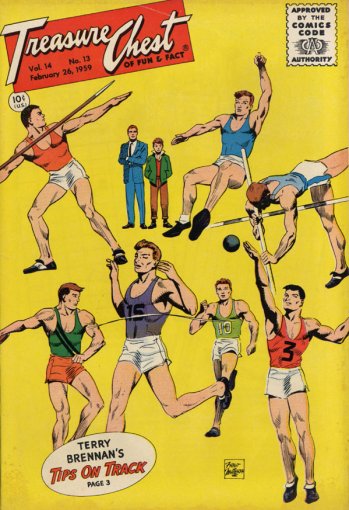 Even
diehard comics fans have generally never heard of Treasure
Chest of Fun and Fact—unless, of course, they went
to Catholic grade school between 1946 and 1972. It was a comic book
produced in Ohio for national distribution to parochial schools,
and maps well to the era of Postwar Triumphal Catholicism. I was
a grade schooler between 1958 and 1966, so Treasure Chest
was always kicking around somewhere, along with Our Little Messenger,
Young Catholic Messenger, and numerous other things that
the George A. Pflaum Company of Dayton was always pumping out. I
read Treasure Chest when it was handy, though I did so absent-mindedly
and was never a big fan. The comic ran the gamut from preachy (always)
to silly (often) and the quality was very uneven. The larger and
long-running series were often beautifully done from a writing and
art standpoint, though much of it glorified sports, which was a
Catholic fetish at that time, in the hopes that young boys exhausted
by sports will not go off by themselves somewhere and, well, you
know. Even
diehard comics fans have generally never heard of Treasure
Chest of Fun and Fact—unless, of course, they went
to Catholic grade school between 1946 and 1972. It was a comic book
produced in Ohio for national distribution to parochial schools,
and maps well to the era of Postwar Triumphal Catholicism. I was
a grade schooler between 1958 and 1966, so Treasure Chest
was always kicking around somewhere, along with Our Little Messenger,
Young Catholic Messenger, and numerous other things that
the George A. Pflaum Company of Dayton was always pumping out. I
read Treasure Chest when it was handy, though I did so absent-mindedly
and was never a big fan. The comic ran the gamut from preachy (always)
to silly (often) and the quality was very uneven. The larger and
long-running series were often beautifully done from a writing and
art standpoint, though much of it glorified sports, which was a
Catholic fetish at that time, in the hopes that young boys exhausted
by sports will not go off by themselves somewhere and, well, you
know.
I was chasing memories around the Web the other night when I discovered
the
Treasure Chest archive at the Washington Research Library Consortium.
This is a wonderful thing, but for copyright reasons it only has
the magazines from 1946 through the end of 1963, which is unfortunate
for reasons I'll relate shortly. I remembered only three of the
continuing series; the rest of it had fled my brain cells until
I started skimming the archive. There were textual letters from
some priest (probably advising young boys not to go off by themselves
somewhere and, well, you know), illustrated lives of the Saints,
and insufferable
lectures by Patsy Manners on etiquette and how to throw good
parties. (Mixed parties! No, don't read that! We don't do
such things in Chicago!) It was a real and sometimes classic comic;
if you read nothing else, check out Kidnaped
by a Spaceship from 1959. If they ran more like that I might
have been an enthusiastic fan, but no; most of what we got was like
Chuck
White and His Friends, which was about an older guy who
took young boys off on wholesome adventures, I'm sure so that they
would not go off by themselves somewhere and, well, you know. Funny
animals were big, and for a bit of prescient comic surrealism (I
flashed on Cerebus) skim The
Bear and the Wicked Wainwright. (At one point the
Wainwright calls the Bear a "base poltroon," which
became faddish on the playground for a few weeks, though I may have
been the only one of us sixth graders who bothered to look up "poltroon.")
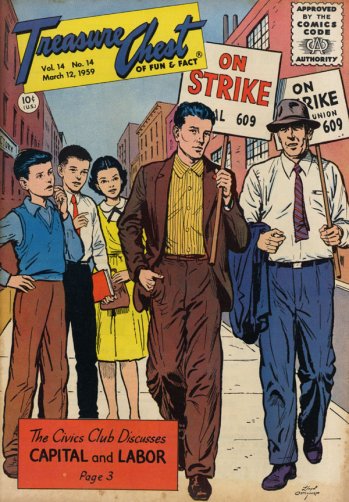 If
Treasure Chest is currently famous for one thing, it was
for the 1961-62 series This
Godless Communism, which still gets the lefties het up.
I rolled my eyes a little then and still do; the problem with Communism
is not its godlessness but the fact that it murdered a hundred million
people in the 20th century alone. Treasure Chest understood
its working-class Catholic audience and was completely comfortable
with praising organized labor in one of its illustrated civics lessons.
No contradictions here; being a liberal has not always meant being
a Marxist. If
Treasure Chest is currently famous for one thing, it was
for the 1961-62 series This
Godless Communism, which still gets the lefties het up.
I rolled my eyes a little then and still do; the problem with Communism
is not its godlessness but the fact that it murdered a hundred million
people in the 20th century alone. Treasure Chest understood
its working-class Catholic audience and was completely comfortable
with praising organized labor in one of its illustrated civics lessons.
No contradictions here; being a liberal has not always meant being
a Marxist.
And Treasure Chest was fundamentally liberal, as the term
was understood in its time. If it has been famous primarily for
This Godless Communism, it may soon become even more famous
for something else: a 1964 series called 1976: Pettigrew for
President! inked by the well-known comics artist Joe Sinnott.
Again, it was a multipart civics lesson: A very slightly futuristic
tale of how a candidate runs for President during the election of
1976—12 years in our future—with a little political huggermugger
thrown in to keep it from being completely boring. (There were a
few scenes with the SST, but in truth not a lot of other futuremongering.
I was disappointed. What? 1976? No flying cars?) What none of us
noticed at the time is that we never actually saw Mr. Pettigrew
full-on. We saw his back, his hands, and so on, but never got a
good look at him. I guess we all figured that it was about the process
and not the man himself, and in truth we were all taken in and completely
poleaxed when on the final page it was revealed that Timothy
Pettigrew was Black! He got the nomination, but beyond that
the story was open-ended. Here's what the final panel said, courtesy
NPR:
"And so this man Pettigrew
became the first Negro candidate for the President of the United
States. He then went out accross the land, this black man, to
campaign for the highest office. Would he win? Well, the year
was 1976. It was the 200th anniversary of the Declaration of Independence.
Could he win? Well, it would depend in part on how the boys and
girls reading this comic grew up and voted ... it would depend
on whether they believed and, indeed, lived those words in the
declaration -- All Men are Created Equal."
Alas, I have yet to see the comic scanned and posted anywhere,
since content published in 1964 and after is automatically still
in copyright. (The earlier issues had not been renewed and thus
passed into the public domain.) The best we can do is a
YouTube video, of all things.
It's a measure of our progress that what was seen as an inspiring
piece of comic book science fiction in 1964 smacks of tokenism today:
So we should vote for him just because he's black? Or dare we ask
whether he has a chance of running the country? (The country may
end up doing a lot of growing up next year, heh.) And if you ever
wanted to invest in comic books, now's the time to hunt down and
grab Treasure Chest Volume 19, issues 11-20. They're going
to be worth something soon, no matter which way things go this fall.

|
 March
7, 2008: Odd Lots March
7, 2008: Odd Lots
- Do not fail to read Bruce
Schneier's latest short item in Wired, which is his
simple demolition of David Brin's peculiar "transparent society"
concept, which I first read of in his so-so novel Earth
(1990) and thought was BS even then. Having no secrets doesn't
help where the differential of power between two parties is high.
This seems pretty obvious to me; I do not understand why Brin
gets points for this "no secrets" notion of his.
- Some of the worst horror films (as well as SF films and some
westerns) can be streamed without charge here.
Where else can you find "Attack of the Giant Leeches"
or "Killer Shrews," both of which I recall seeing on
Channel 7 at 4 PM on Thursdays back 1965-ish. Even at age 12 I
could roll my eyes and say, "Those aren't giant shrews. Those
are dogs in bad shrew costumes." But hey, that's what makes
a B-movie a B-movie, right?
- It may be clever, but can a
gun this small really be deadly? (That is, assuming you don't
aim it up your left nostril...)
- This is freaking amazing: Images
of a landslide on Mars, taken while it's happening. (Thanks
to Pete Albrecht for the link.)
- Jim Strickland pointed out a
pneumatic tennis-ball based antenna launcher. We always used
slingshots back in the day, and I have a Greenlee Cablecaster
that was designed for dragging CAT5 over suspended ceilings via
fishline, but something about the ball shooter is very
appealing.
- Glover Wright is bringing back Science
Fiction Quarterly as an online pub, and it looks promising.
I recall reading a few ancient issues of the original SF Quarterly
pulps from the late 50s and was pleased, though the world and
I were, um, at least thirty years younger then. The first issue
will be out in March.
- Gripe of the week: The keycap letters on my
expensive Avant Stellar keyboard are decals, and they
are already wearing off. It's only been a year. What's this
thing going to look like after another ten?
- Speaking of keyboards: I need a wireless keyboard for use while
sitting on the couch and running photos or video clips on our
big TV. The SX270 is under the TV in plain view of the couch.
The keyboard needs to have an integral pointing device. (I prefer
things like IBM's TrackPoint nipple to the ubiquitous scratchpad.)
Anybody got any suggestions?

|
 March
3, 2008: Fruit Wine and Pork Stew March
3, 2008: Fruit Wine and Pork Stew
Not much time tonight, but it's worth reporting a recipe that Carol
threw together off the top of her head earlier today:
Pork Stew
Cut a two-pound pork
roast (not a loin) into 1/2" cubes. Sprinkle flour on a cookie
sheet and then salt the flour. Coat the pork cubes with flour
and salt, then brown them in oil. Add half a 750 ml bottle of
some sweetish wine. We used Mountain Spirit Winery's Angel Blush,
a fruit wine consisting of 40% apple, 40% pear, and 20% raspberry.
Cover and simmer the browned meat in the wine while you cut up
three Yukon Gold potatoes and two apples (we used Braeburns) into
similar sized cubes. Simmer for three-four hours. It's not critical.
Add water if the liquid level gets too low. The apples will break
down and contribute some body to the gravy. Makes a lot; we should
get three suppers out of it.
I tend to like sweeter wines, but I've never really warmed to fruit
wine of any kind. I just finished the bottle of Breezy Hills Raspberry
we brought home from Iowa (near Minden) last October, and it wasn't
terrible but wasn't great. Fruit wines tend to taste yeasty to me,
a little like beer, and I don't know if it's just a taste quirk
of mine, or if I simply haven't tried any really good fruit wines.
The stew recipe was an experiment to see if stews (which can sometimes
have a sweet edge to good effect) could be simmered in a sweet wine.
The Angel Blush is a little too sweet to drink in any quantity,
so we used it in the stew, and it worked very well. I don't think
I would cook a darker meat in sweet wine, but for whatever reason,
it went beautifully with lean pork. Give it a shot.

|
 March
2, 2008: Odd Lots March
2, 2008: Odd Lots
- I remember reading somewhere years ago that having a photo of
a box on your Web store improves your sell-through of downloadable
software, even if the product is never sold in a box and even
if the box doesn't even exist. Anyway, here is a
product that helps you create imaginary product boxes.
- Here's another very similar
product. We evidently have a small industry here that I had
never heard of before this morning.
- And yet another:
This time, it generates a 3-D rotating video of an imaginary box!
- After a little further research, I'm guessing that the "online
affiliate marketing" industry is driving the imaginary
box subindustry. On the other hand, the online affiliate marketing
industry is itself imaginary, and basically a scam that labors
mightily to stay just half a hair on the legal side of the razor.
It's what the 419 scams would be if Nigeria had something like
the FTC.
- From Pete Albrecht comes a link to a
video showing how well a 21-foot (!!) X-wing model rocket flies.
(Flies? So-so. Dies? Spectacularly!)
- Don Lancaster has a detailed article (PDF format) about why
rooftop PV solar power isn't as big a win as everybody says it
is. Definitely worth reading, and pay especial attention to
the description of exergy,
a concept I had heard of but not understood until now. As with
TTL and CMOS logic, Don finally made it click for me.
- Is Flash memory "write endurance" (i.e., the number
of times you can change the state of a Flesh emmory cell) a serious
issue or not? I always thought it was, but Eric Brombaugh (one
of my EE friends who knows a thing or two about such matters)
sent me a link to an
article that changed my mind. If you're interested in Solid
State Drives (SSDs) the
parent page is worth a look as well.

|
 March
1, 2008: The Friction Is In the Discovery March
1, 2008: The Friction Is In the Discovery
I don't buy a lot of music anymore, and in thinking back, I suspect
that I stopped buying when I stopped listening to the radio. (I
stopped listening to the radio because the stations play the same
sixteen stupid songs every twenty minutes...forever. But that's
a separate rant.) The tough part in selling anything is discovery—basically,
getting the prospective customers to know that you exist—and
it becomes a lot tougher when you slide from machine screws to wine,
and incomparably tougher yet when you move from wine into the realm
of art. Absent radio, I discover new music a lot less often. Here's
a recent discovery tale that did lead to a purchase, and if I were
the artist I'd be maybe a little annoyed:
Carol and I don't watch a lot of TV, but we turn on the Weather
Channel before we go to bed to catch Local on the 8s, and then again
in the morning over breakfast. The Weather Channel plays "smooth
jazz" during its canned local forecasts. My affection for smooth
jazz is sparse, albeit less sparse than my affection for what I
call club jazz. No sax please; we're contrarians—I think I
dislike sax music because almost everybody else worships it. A few
mornings ago, I looked up over my Cheerios to watch Local on the
8s, and realized that there were no saxophones playing. Better
still, it was not the usual mournful, shapeless noodling, but a
purposeful, upbeat (nay, near-manic) piano piece. Two minutes later,
the forecast over and the music cut short by yet another Mucinex
mucus man commercial, I ran out of the kitchen to the machine here,
muttering, "I gotta have that!"
Alas, the Weather Channel does not announce the artists on its
forecast music, so I hammered out a quick email to them, after spending
several minutes digging through their site looking for a contact
link: Please, folks, what was the title/artist of the bouncy piano
piece playing during today's 6:58 AM Local on the 8s?
I only half expected an answer, and was working on memorizing the
piece so that I could whistle it to whomever I might know in smooth
jazz fandom. But yay wow, by late afternoon, I got a nice note from
a Weather Channel junior staffer who confessed that she didn't know
precisely, but the February AM playlist was attached. And so it
was: The email carried an Excel spreadsheet containing the titles
and artists for 15 songs, one of which was by implication the bouncy
piano piece. I just didn't know which one.
I had done this kind of detective work a time or two before. I
first looked up the artists, separating the pianists from the sax
maniacs. It came down to either Leo Tizer or Bradley Joseph. I went
over to Amazon, looked up the artists, and started playing the samples
for the album tracks named in the playlist spreadsheet. On the third
try, I got it: Brandley Joseph's "Rose-Colored Glasses"
(and Bradley himself) had been discovered. Ninety seconds later,
I had purchased
the track through One Click for 89c, and had a DRM-free MP3
in my music directory. Ninety seconds after that, I had his CD album
(Hear
the Masses) on its way. The friction was all in the discovery.
Amazon supposedly sells two million music tracks as unencumbered
MP3s. I shop for music so rarely that I didn't even know this. I
did know that Amazon has been selling PDF-formatted short stories
(and other short textual works, including nonfiction) for a couple
of years now, for 49c a pop. Alas, by the time I decided to apply
to the program, they had closed it to new submissions, but the delivery
mechanism is the same as for MP3s: If you have One Click enabled,
you get the item in a few seconds.
I think Amazon
Shorts may have been doomed because Big Name Writers would not
sell unencumbered PDFs, and Small Name (or No Name) writers do not
sell enough of anything to justify the effort it takes Amazon to
vet them and post them. Or perhaps Amazon is simply migrating the
program to Kindle. We'll find out eventually. The point to be taken
away here is that we have digital delivery down cold. Discovery
is fluky and always will be, especially for things like fiction,
which (with vanishingly rare exceptions) you do not hear on the
radio. Amazon can make the gumballs drop into your hands. We're
still not sure how they'll make you want the gumballs, but tougher
problems have been solved.
In the meantime, Bradley Joseph has another fan, and might have
more if the Weather Channel would just put his name in the corner
of the screen while they're playing his music over their forecasts.
I hope he got some cash for the license, because not everybody is
going to dig as hard as I did!

|
|
